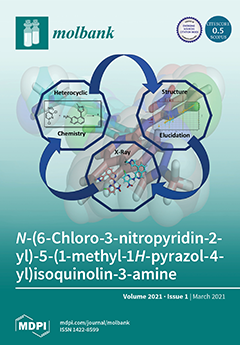A new compound tetramethyl 1,1′-(2-[{4,5-
bis(methoxycarbonyl)-1
H-1,2,3-triazol-1-yl}methyl]-2-[(4-methylphenyl)sulfonamido]propane-1,3-diyl)
bis(1
H-1,2,3-triazole-4,5-dicarboxylate)
(3) was prepared in two steps starting from 2-((4-methylphenyl)sulfonamido)-2-((tosyloxy)methyl)propane-1,3-diyl
bis(4-methylbenzenesulfonate) (
1), with an overall yield of 74%. The key step being the copper-free Huisgen cycloaddition between
N
[...] Read more.
A new compound tetramethyl 1,1′-(2-[{4,5-
bis(methoxycarbonyl)-1
H-1,2,3-triazol-1-yl}methyl]-2-[(4-methylphenyl)sulfonamido]propane-1,3-diyl)
bis(1
H-1,2,3-triazole-4,5-dicarboxylate)
(3) was prepared in two steps starting from 2-((4-methylphenyl)sulfonamido)-2-((tosyloxy)methyl)propane-1,3-diyl
bis(4-methylbenzenesulfonate) (
1), with an overall yield of 74%. The key step being the copper-free Huisgen cycloaddition between
N-(1,3-diazido-2-(azidomethyl)propan-2-yl)-4-methylbenzenesulfonamide (
2) and commercially available dimethyl acetylenedicarboxylate. The chemical structure of compound
3 was determined by IR, 1D and 2D NMR experiments, and elemental analysis.
Full article





